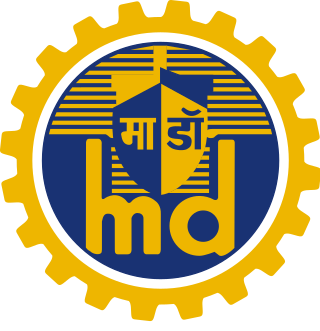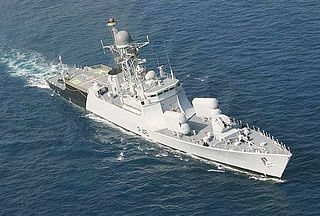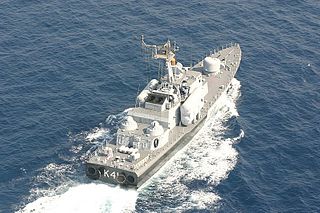
PNS/M Hangor (S-131) was a Daphné-class diesel-electric submarine that served in the Pakistan Navy from 1969 until its decommissioning in 2006. It is the first submarine to sink a ship after World War II.

The Rajput-class guided-missile destroyers built for the Indian Navy are modified versions of Soviet Kashin-class destroyers. They are also known as Kashin-II class. The ships were built in the former Soviet Union after considerable Indian design modifications to the Kashin design. These included the replacement of the helicopter pad in the original design with a flight elevator, as well as major changes to the electronics and combat systems. Five units were built for export to India in the 1980s. All units are currently attached to the Eastern Naval Command.

INS Rajput was a guided-missile destroyer and the lead ship of the Rajput class of the Indian Navy. It was commissioned on 4 May 1980. It was the first destroyer of the Indian Navy. It was built for India by the erstwhile USSR, and had the shipyard name Nadezhny. Captain Gulab Mohanlal Hiranandani was her first commanding officer.

INS Khukri was a Type 14 (Blackwood-class) frigate of the Indian Navy. She was sunk off the coast of Diu, Gujarat, India by the Pakistan Navy Daphné-class submarine Hangor on 9 December 1971 during the Indo-Pakistani War of 1971. It was the first warship sunk in action by a submarine since World War II. It is the post-independence Indian navy's only warship to have been lost in war.

The Nilgiri-class frigates were updated versions of the Leander class, designed and built for the Indian Navy by Mazagon Dock Limited in Mumbai. Six ships were built between 1972–81. Vessels of the class formed the 14th Frigate Squadron. The lead ship INS Nilgiri was the first major warship to be built in India and was built in collaboration with Yarrow Shipbuilders of the United Kingdom.

The Godavari-class frigates were guided-missile frigates of the Indian Navy. The Godavari class was the first significant indigenous warship design and development initiative of the Indian Navy. Its design is a modification of the Nilgiri class with a focus on indigenous content of 72%, a larger hull and updated armaments. The class and the lead ship, INS Godavari were named after the Godavari River. Subsequent ships in the class, INS Ganga and INS Gomati also took their names from Indian rivers.

Mazagon Dock Shipbuilders Limited (MDL), formerly called Mazagon Dock Limited, is a company with shipyards situated in Mazagaon, Mumbai. It manufactures warships and submarines for the Indian Navy and offshore platforms and associated support vessels for offshore oil drilling. It also builds tankers, cargo bulk carriers, passenger ships and ferries.

INS Godavari (F20) was the lead ship of her class of guided-missile frigates of the Indian Navy. Built by Mazagon Dock Limited in Mumbai, she was the first Indian warship to be indigenously designed and built. She was commissioned on 10 December 1983, and decommissioned on 23 December 2015 after a 32-year career.

Captain Mahendra Nath Mulla, was an officer of the Indian Navy. As the commanding officer of INS Khukri, he chose to go down with his ship when his ship was sunk during the Indo-Pakistani War of 1971.

The Khukri-class corvette , also known as Project 25, is a class of corvettes intended to replace the ageing Petya II-class corvettes of the Indian Navy.
The following ships of the Indian Navy have been named Khukri:

The Abhay-class corvettes of the Indian Navy are the customised variants of the Soviet Pauk-class corvettes. The class was primarily intended for coastal patrol and anti-submarine warfare. The last ship of the class is expected to be decommissioned by 2025. The class is being replaced by Arnala-class and Mahe-class of Anti-Submarine Warfare Shallow Water Craft. The ships formed the 23 Patrol Vessel Squadron of the Indian Navy.

The Veer-class corvettes of the Indian Navy are a customised Indian variant of the Soviet Tarantul class. They form the 22nd Missile Vessel Squadron.
INS Ajay (P34) was an Abhay-class corvette, in service with the Indian Navy. She inherited her name from INS Ajay, the first warship built in independent India, which served in the Navy from 1960–1974.

INS Kirpan is the name of a Khukri-class corvette formerly commissioned by the Indian Navy. It was recently decommissioned and handed over to Vietnam People's Navy in a ceremony presided over by Adm. R. Hari Kumar and Rear Adm. Pham Manh Hung, Deputy Commander-in-Chief and Chief of Staff, Vietnam People's Navy.

The Sandhayak-class survey ships are a series of eight vessels built by Garden Reach Shipbuilders and Engineers (GRSE), Kolkata and Goa Shipyard, Ltd., Vasco for the Indian Navy. While Sandhayak, Investigator, Nirdeshak, Nirupak were built in GRSE; Sarveshak, Jamuna, Darshak, Sutlej were built by Goa Shipyard. The vessels equipped with four survey motorboats, two small boats and are powered by two diesel engines with a top speed of 16 knots. They have a helicopter deck and are also armed with a Bofors 40 mm/60 gun mount for self-defense.
INS Nirupak (J20) was a Sandhayak-class hydrographic survey ship in the Indian Navy. The ship was built by Garden Reach Shipbuilders & Engineers and commissioned into the Indian navy at Visakhapatnam naval base in 1985 under Eastern Naval Command.















